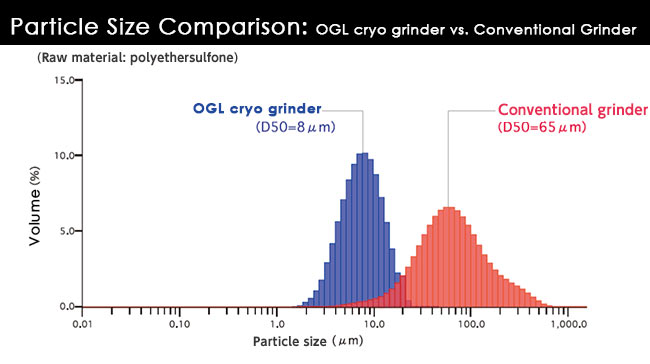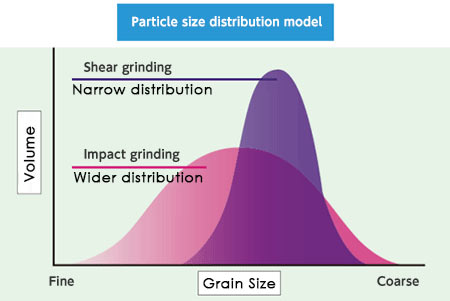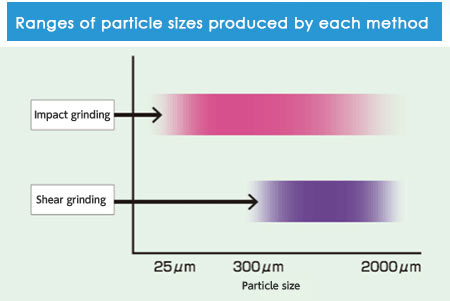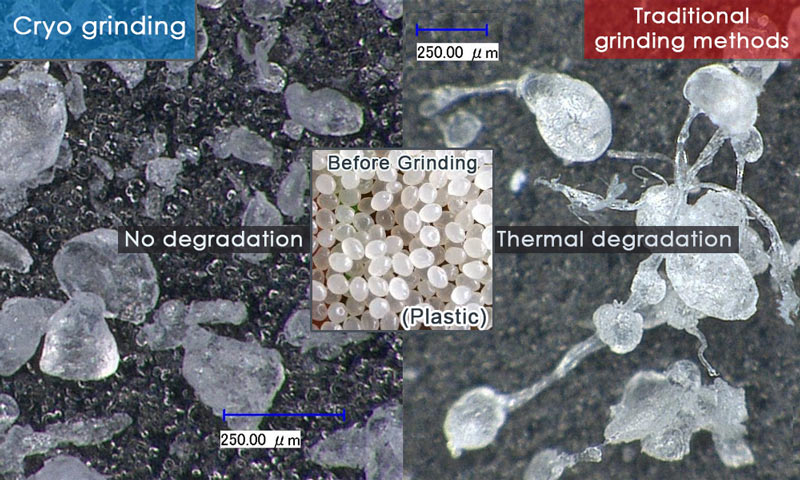Q. What are the advantages of cryo grinding?
A. Everything.
Cryogenic vs Conventional Grinding
| Cryo Grinding | Conventional Grinding | |
| Temperature | -320°F (-196°C), Embrittling | Ambient to 392°F (200°C) |
| Particle sizes | Ultra-fine, D50<10μm | Fine, D50~65μm |
| Material Oxidation | None, inert atmosphere | Uncontrolled |
| Powder fluidity [Plastics] |
Maximized inter-particle cohesion | Standard |
| Thermal Deforming [Plastics] |
Mitigated by cryogenic temperatures | Uncontrolled |
| Flavor Compound Retention [Food] |
Improved, volatile compounds chilled below glass-transition temperature | Uncontrolled |
| Texture [Food] |
Enhanced by narrow particle size distribution | Traditional |
Cryogenic Grinding Key Advantages

Ultra-fine Particle Grinding
OGL’s cryo grinding process produces much more finely ground particles than conventional milling methods. OGL cryo mills are able to grind many materials to 10µm average particle size or smaller. This improves the particle flow of polymers and dispersion potential for processed polymers and foodstuffs in liquid.


Uniform Particle Distribution
Grinding at cryogenic temperatures creates ultra-fine particles in a very narrow distribution range. Coupled with our customizable sieving system, OGL can evenly classify materials to maximize the yield, stability, and performance of your product. Our sieving systems can be adjusted for a wide variety of application needs.
Plastic Cryogenic Grinding Examples:
Super engineering plastics
Our cryogenic grinding technology grinds even resins characterize by high mechanical strength.

Fluorocarbon resin
Our cryogenic grinding technology makes it possible to grind even soft resins.
The technology suppresses whiskergeneration.

Biodegradable resin
Our cryogenic grinding technology makes it possible to grind resins with low softening points.
In addition, the technology eliminates thermal metamorphism.

Elastomer (rubber)
Our cryogenic grinding technology makes it possible to grind even elastic reins characterized by low melting points.


No Thermal Degradation
Temperature management is one of the main challenges of industrial grinding. During operation, the ambient temperature inside conventional mills can rise to over 390°F (200°C). At that temperature many materials deform or melt before they can even be pulverized. Other materials may not degrade, but remain too flexible to properly grind.
OGL engineers use liquid nitrogen to both chill materials before grinding, and to maintain ultra-low temperatures while the mill is in operation. Chilling raw materials to cryogenic temperatures embrittles them, which means they fracture rather than bend, melt, or otherwise deform during milling. This makes cryogenic grinding the optimal method for grinding a wide range of materials unsuitable for conventional grinding.

Polymer Grinding Comparison
OGL’s dedicated polymer cryo grinding centers are capable of processing raw materials for a wide range of industrial and technological applications.
Polymer Applications
- Composites (CFRP, CFRTP)
- High-performance compounding
- Rubbers (Elastomers)
- Hot-melt adhesives
- Powder bath coatings
- Fluid-dip coatings
- High-tech precision materials
- Masterbatch powders
- Fluorocarbon resins
- Electrostatic paint powders
- 3D Printing powders (PBF, SLS)
Constant Research and Development
OGL cryo grinding processes are always under active development. Contact an OGL Service Rep to stay up to date on upcoming enhancements, optimizations, and new grinding options.
Call us on
+1 847.481.8264
Email us
osaka-g777@aaamachine.com
